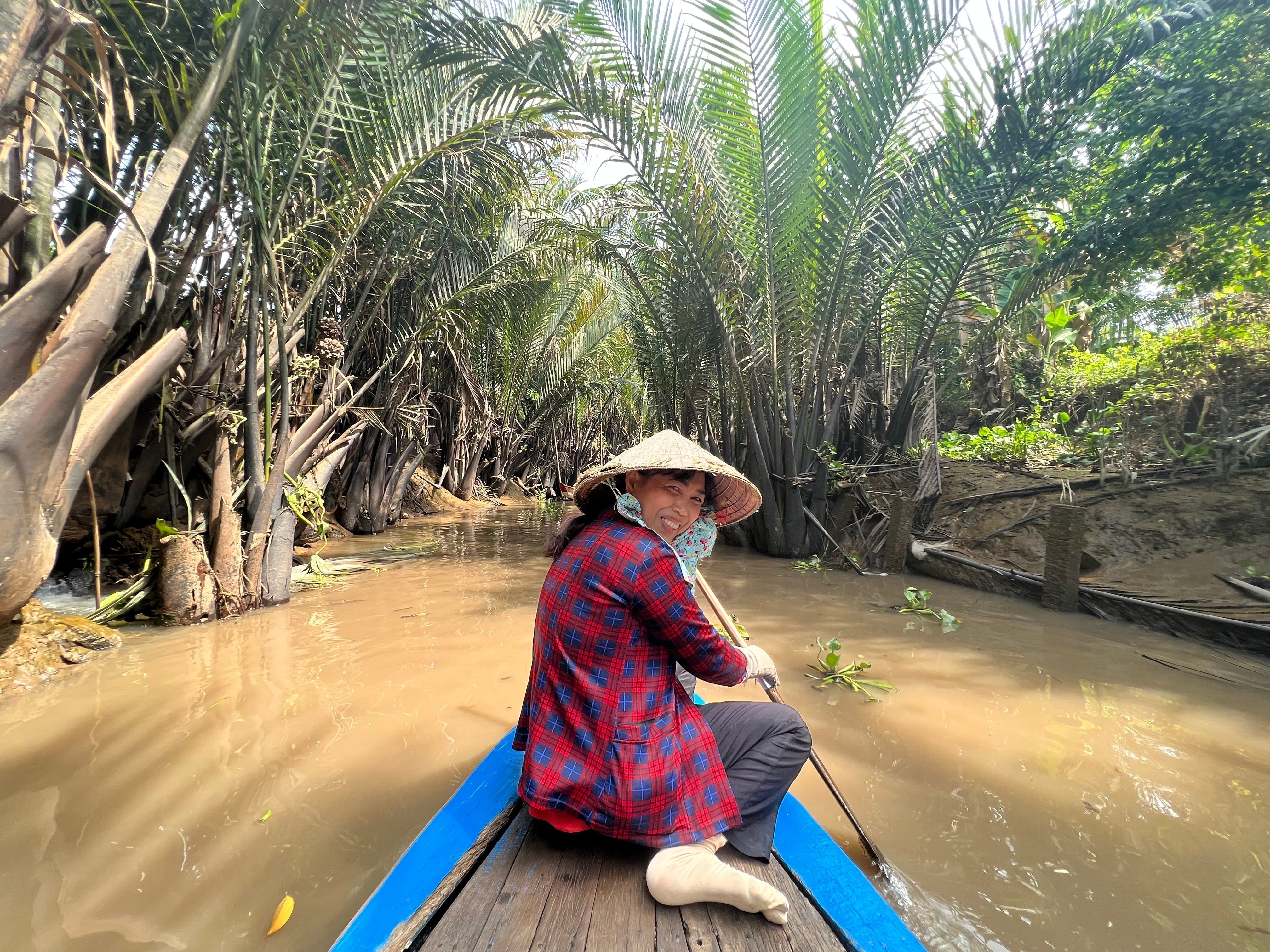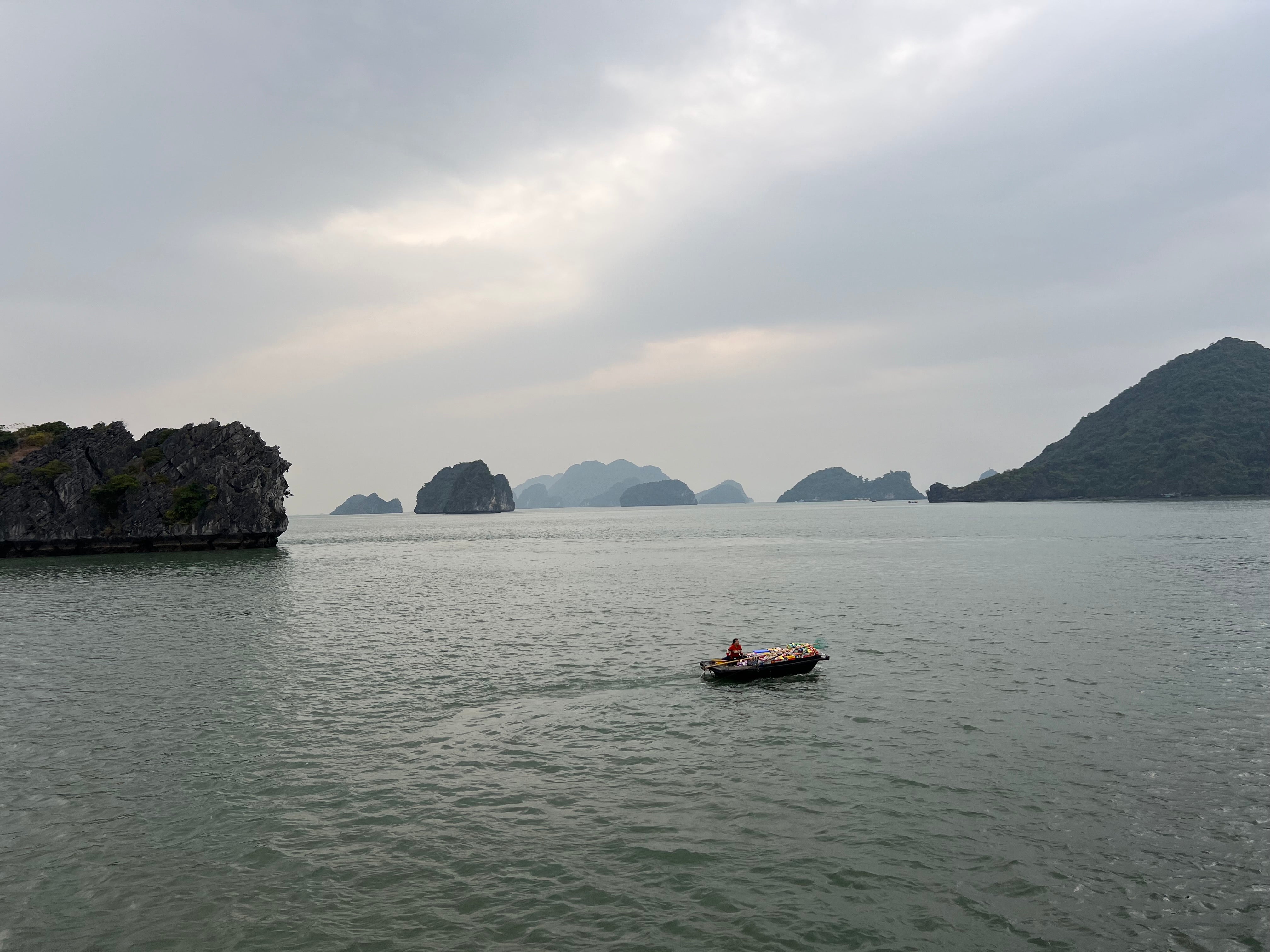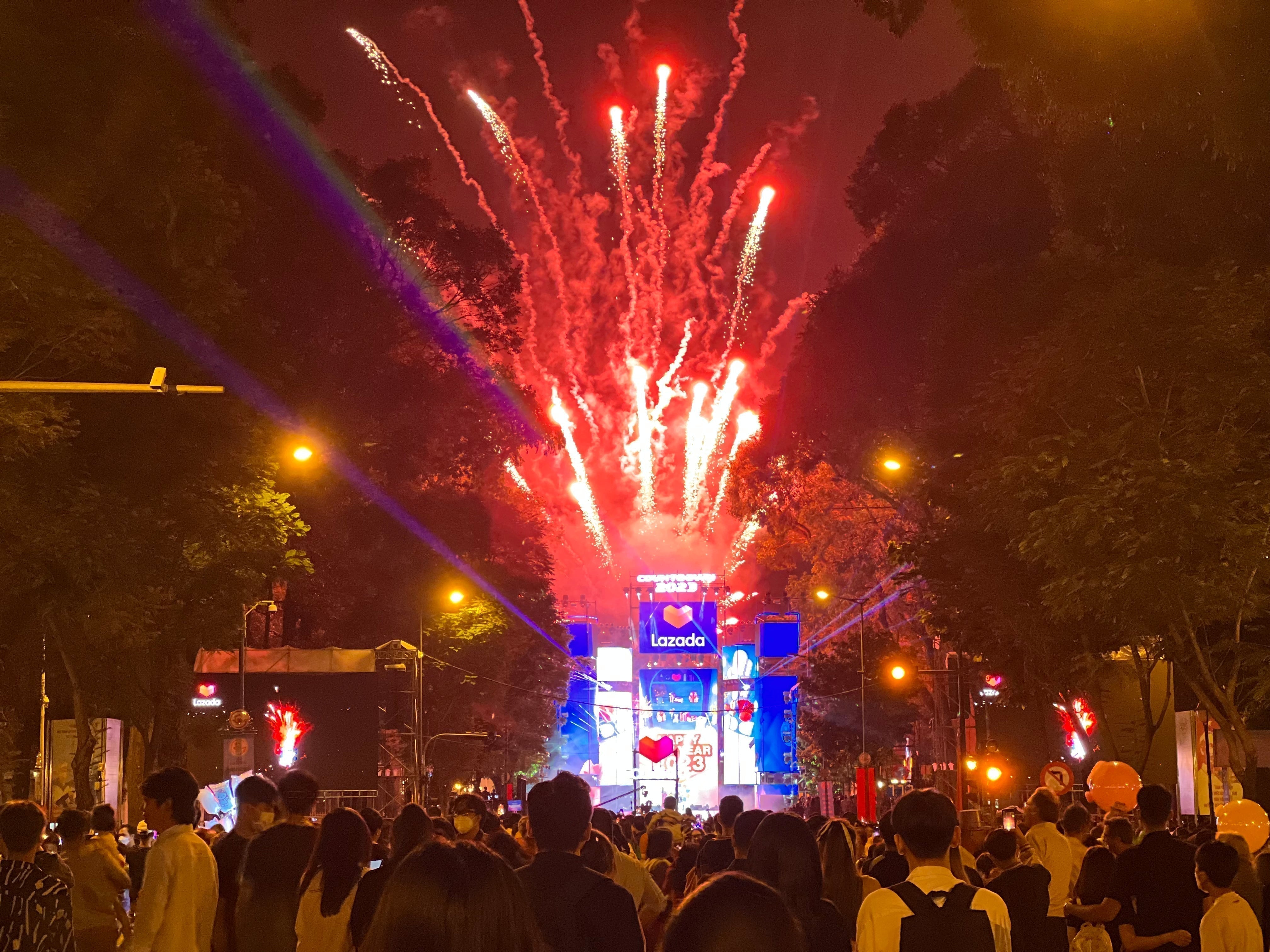
Barely Breathing Through The Holidays In Saigon, Vietnam (Part I)
Mike and I would like to think that we thrive on chaos. Not the type where we risk our lives by trekking in Somalia, or visiting war zones in Iraq — I know there are explorers far more brave than us — but the type where we find chaotic situations that are normalized in other countries and experience it first hand. This is exactly what we did when we decided to spend Christmas and New Years Eve in Saigon, Vietnam.

In December of 2022, we decided to fly to Vietnam and discover Saigon (Ho Chi Minh), Hanoi, and Ha Long Bay (you can see my blog post about Ha Long Bay here). We landed on December 24th, Christmas Eve, and the entire city was already alive. The Notre Dame Cathedral, though still under renovations, was packed with people dressed in santa and sexy reindeer outfits. The Union Square had giant lit up ornaments lining the streets. Everything was covered in Christmas lights and it was a warm-weathered winter wonderland.


We passed by a few kids that were spraying turpentine out their mouths to create a breath of fire. That wasn’t the most comforting thing to watch for many, many reasons, but it was also very entertaining. I hate that I get entertainment off of other people’s s recklessness but that’s also why my generation was into the show Jackass.

Our hotel was the Hôtel des Arts Saigon - MGallery Collection, which I'll refer to as "M Gallery" going forward, and as you walked in, a giant christmas tree lit up the lobby and there was a chorus group chanting Christmas carols all night long. If I didn’t know any better, I would think a lot of Vietnamese people are christians celebrating christmas — but the reality is everyone is celebrating christmas more as a cultural event rather than a religious one. Vietnam is traditionally a Buddhist country, but christmas has recently become a big thing in more urban areas as it brings a lot of commercial activity and ultimately, tourism.

That said, because christmas is more of a commercially celebratory day than a national holiday, we were able to still do all of the normal touristy activities on Christmas day. the next day, we head to our first full day in Saigon.
Early morning, we woke up and head to the breakfast buffet at M Gallery. I am not exaggerating: this is one of the best breakfast buffets we have ever had, period. Vietnam has so much french food because of the French colonial rule from 1858 to 1954, which means that they have everything french with a Vietnamese flair. We are talking a French-Vietnamese cuisine, from incredible croissants, to exquisite pho. I can’t believe how much I loved the breakfast options; to have a range of euro-asian dishes made perfectly available at a buffet, was utterly mind blowing. Needless to say, we dont usually do this, but we ate breakfast at the hotel every single morning.


The first stop was Lang Viet Lacquers, a small factory where Agent Orange victims of the Vietnam war were trained to become highly skilled lacquer painting (sơn mài) artisans. We learned that sơn mài is extremely time consuming: on top of embedding lacquer, morther-of-pearl, eggshells, gold foils, and natural paints to create beautiful art on wood, its a process that involves resin, grinding, polishing, to get it to the finished state.

We were blown away by their skills and artistry, so we went ahead and bought an entire wall piece for our home, determined to bring it all the way back to Kaua'i. Spoiler alert: we succeeded, due to their extremely skilled ability in packing and shipping.

Victims of Agent Orange in Vietnam nowadays are mostly the new generation of people - people who were born during and after the war. They were born with different kinds of disabilities, from missing or deformed limbs, impairment in their senses, cancers, immune disorders.. the list goes on because literally, Agent Orange is one of the most poisonous substances known to science.
Okay, so how did Agent Orange get to Vietnam? Surprise surprise - the war with America. At a certain point, due to the fact that the Vietnamese people were fighting with guerrilla tactics in the jungle (and winning), American military decided to use Agent Orange for deforestation, crop destruction, and ultimately, psychological warfare. Scorched earth means no safe zone for anyone. It was mostly deployed via aerial spraying over vast areas - as an example, about 12% of South Vietnam (the size of Massachusetts) was sprayed. Over 20 million gallons of Agent Orange was sprayed throughout the war, and over 4.5 million Vietnamese civilians were exposed.

Needless to say, being in Vietnam, eating their food, enjoying their warm hospitality, and being in awe of their celebration of western traditions such as Christmas: this hits heavy on our first full day.

After witnessing the artisans create sơn mài in person, we head to our next heavy hitter: Củ Chi Tunnels. The Củ Chi Tunnels is a vast underground network near Saigon that stretches over 250 kilometers that Vietnamese guerrilla fighters used for hiding, living, storing supplies, and launching surprise attacks against the American military. This is the reason behind the US’s reasoning to why they needed Agent Orange: not being able to infiltrate the tunnels gave the Vietnamese fighters a massive upper hand. These tunnels has trapdoors, kitchens, hospitals, sleeping quarters, basically allowing the guerrilla fighters to move undetected and survive intense bombing. Today, these tunnels are a symbol of Vietnamese resilience and wartime ingenuity - they are simply bad ass people for standing up against the Americans and arguably, winning, using recycled metals and bamboo sticks.


Okay, depressing day. First order of things for our first full day in Vietnam: Pho. We decided to drop by Pho Hung, famous for some of the best Pho in Saigon. It did not dissapoint -- it has the whole experience of authenticity (the menu was in Vietnamese, even!) and taste (I still dream about it until this day). The southern Vietnam is different than the north - everyone has their own taste to which one they like best. In the south (Saigon), the broth is sweeter, darker, and more complex, because they use added sugar and fish sauce. Its also served with your typical US-style pho garnishes like Thai basil, bean sprouts, cilantro, lime, and chilis. The pho in the north, however, is known to be clear, light, and subtle. I personally loved the pho in the north more because I thought I could eat it as a staple meal everyday - but to each their own.

Let’s head to Bui Vien walking street, or Pho tay, where it’s lively at all times of the day, mainly at night. But Mike and I needed a good time and beer after all the morning shenanigans. We hung out at an uber-western sports bar and I won at darts. Honestly, this place feels like it would be the red-light district of Saigon.

We ended our day with dinner at Quán Ngon 138, a cute restaurant in an ancient Hue-style house, reflecting traditional Vietnamese architecture. They had pathways that were filled with koi ponds and ceilings made of carved wood. Surprisingly, I didn’t love the food as much as I did other restaurants throughout this trip but I realized later why that was the case: we didn’t know how to eat with the dry rice paper they provided with the meals. You’re supposed to wet the rice paper first before eating it, dummies!

Bright and early the next day. After breakfast, we were picked up by our tour guide to discover the famous Mekong Delta. I’m so excited as this was supposed to be the highlight of our trip to Saigon. We drove to Mỹ Tho, the gateway to the Mekong Delta, where long tail boats leave by the hour. We took one of these rackety boats that had bumper tires tied to the sides of it. At least I know the boat might float in case of emergencies.


After a short boat ride, we we dropped off at Thoi Son Isle, a lush river-bound island in the Mekong Delta, where we tried local royal jelly, walked through open-air workshops, and ate durian over the beautiful singing of a đờn ca tài tử group, which is a form of traditional southern Vietnamese folk music. They really loved Mike - they kept telling him how handsome he was. I better watch out for these ladies!



Finally, after walking through a cute little farm, we got on these flat-bottomed sampan boats, with a lady paddling up front and a man paddling in the back. We weaved through the brackish canals that were surrounded by Nipa palms, which is an uber trippy coconut-like palm tree. The trunk itself grows underground the muddy waters with the fronds showing above. The fruits look like coconut clusters, but are spiky instead of round. We didn’t get to try the Nipa coconut-like fruits, because apparently they taste just okay - a bit fibrous and brand. They do use the sap for sugar, alcohol, and medicine though.


After our boat ride, we head out of the island through a small coconut candy factory and a market where they tried to convince us to drink snake alcohol. We didn’t - it was too early in our trip to be adventurous with our stomach.


Finally, we’re back on our motorized rackety boat. The boat ride takes us to Tân Thạch, Châu Thành District Province. Our guide hired a horse carriage to take us around, which we probably would have voted against if we knew beforehand, but out of respect for her work I kept my mouth shut about the conditions this horse might be living in and my own moral compass against enslaving animals for tourism. That said, it was still a charming experience, as we sat next to the carriage drivers son who was just tagging along for the day. We weaved through quiet backroads and passed by fruit orchards, coconut groves, and traditional homes, before finally being dropped off at Nha Hang Sinh Thai Viet Nhat, which literally translates to "Ecological Restaurant" in Vietnamese.


I’m not sure how I feel about this place. On one hand, it’s of course, a wonderful vibe, with a nice riverfront setting and outdoor dining. The fried fish was absolutely incredible and it is literally one of the thousand reasons why I love eating out in southeast asia.


But just like any other southeast asian experiences, I am wrecked by animal tourism. This place has all sorts of caged animals that probably should exist in the wild: from giant boas, crocodiles, birds, porcupines, all living in tiny cages or large empty cement pools. I am not a fan.



After lots of boat adventures and food, we finally head home. That was a long day.

What is the best thing to end a full day? Food delivery. We had THE best Bahn Mi I have ever had in my entire life, period. This legendary Bahn Mi was delivered from Bánh Mì Huynh Hoa, and I swear it was at least a whole foot long. They’ve been open since 1989 and always have long lines (hence, delivery was a fantastic idea), and I can see why.

Anyway, that was the first part of our trip to Saigon. We then headed to Hanoi, which I might write about another time — but in the meantime, wait for Part II of our Saigon story, where we return back just in time for New Years Eve. We find out the hard way that Mike and I are not, in fact, the adventurers I thought we were.




Leave a comment
This site is protected by hCaptcha and the hCaptcha Privacy Policy and Terms of Service apply.